
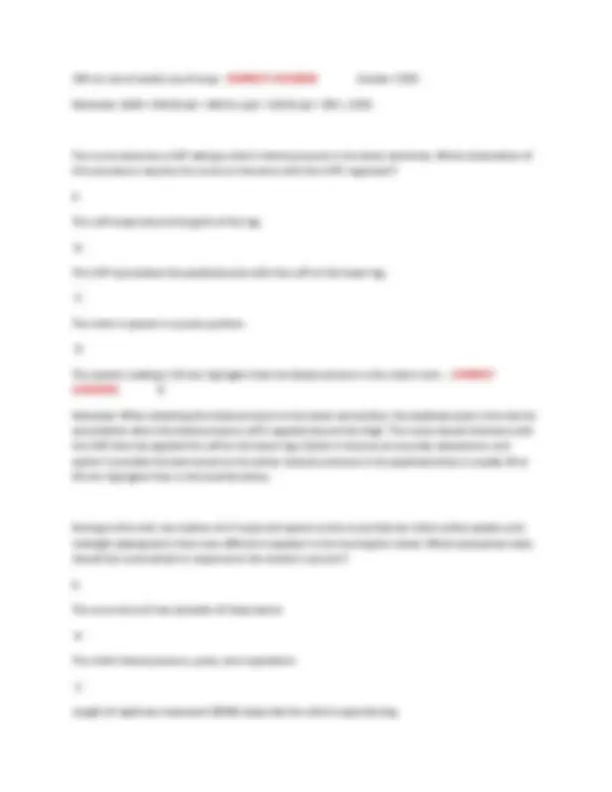
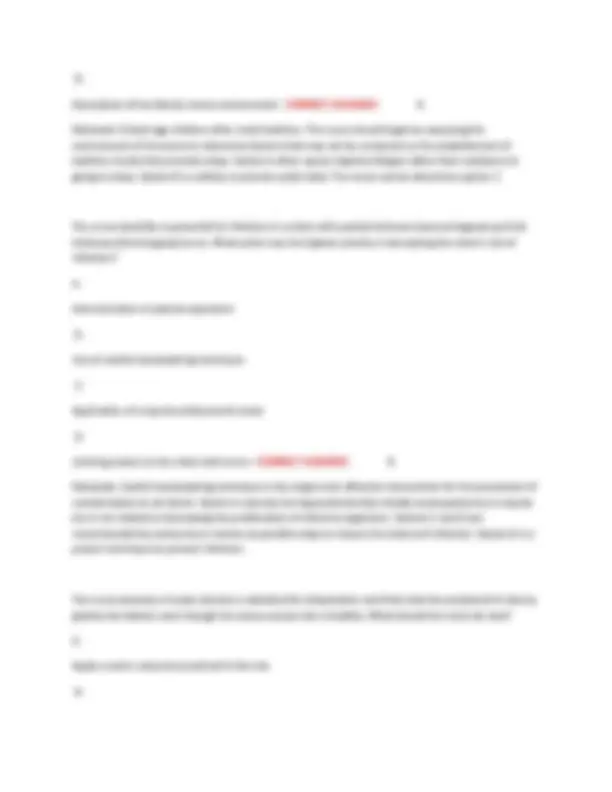
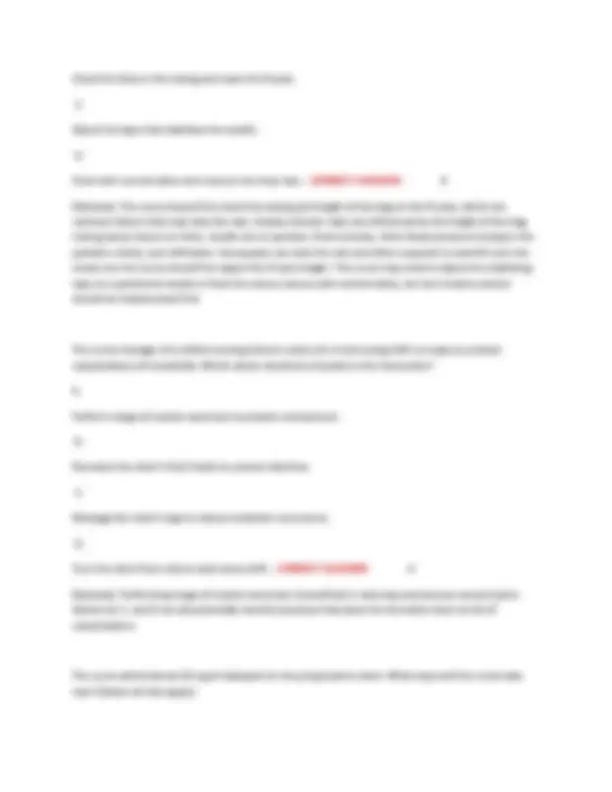
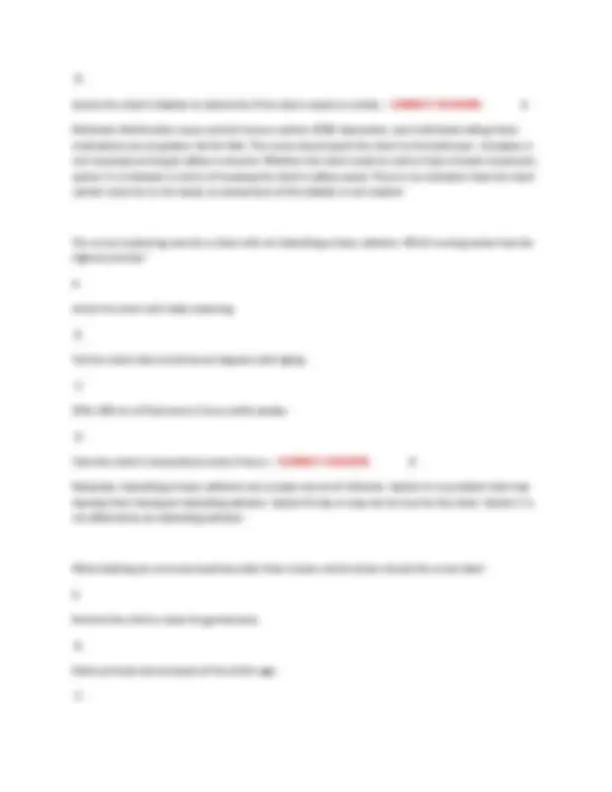
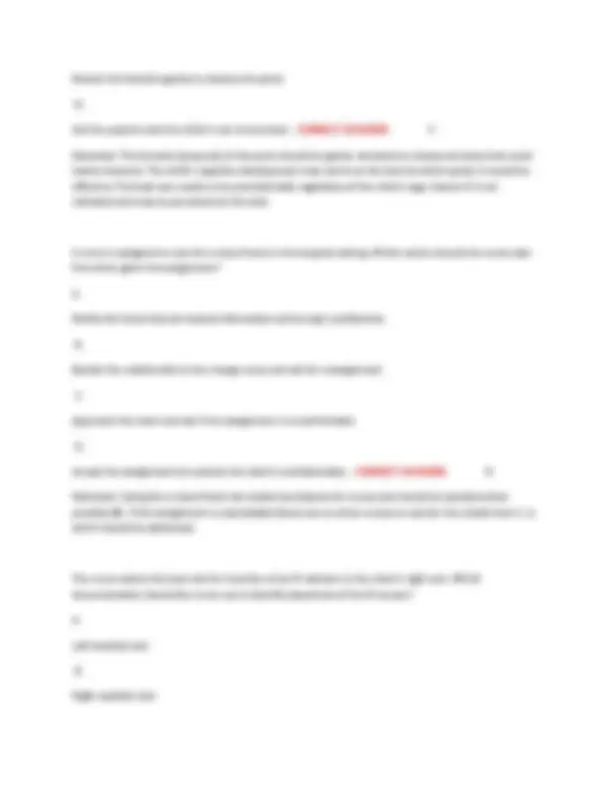

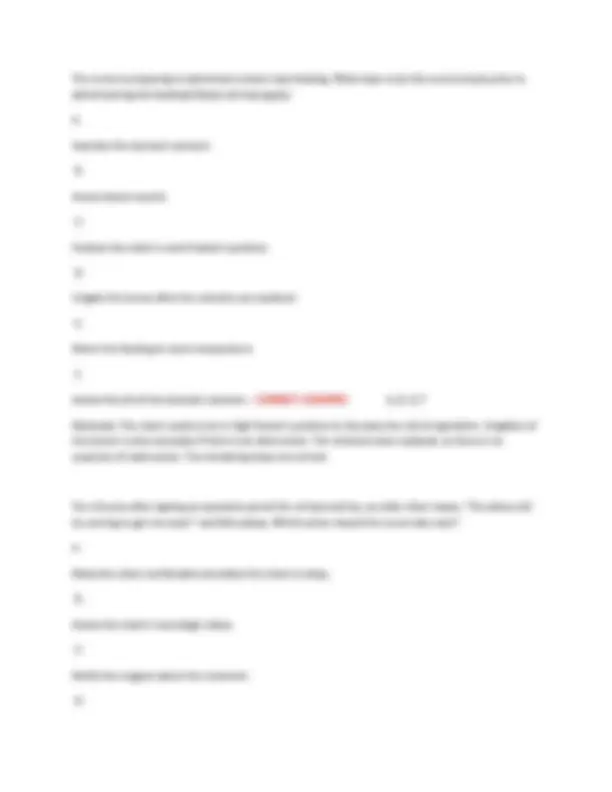
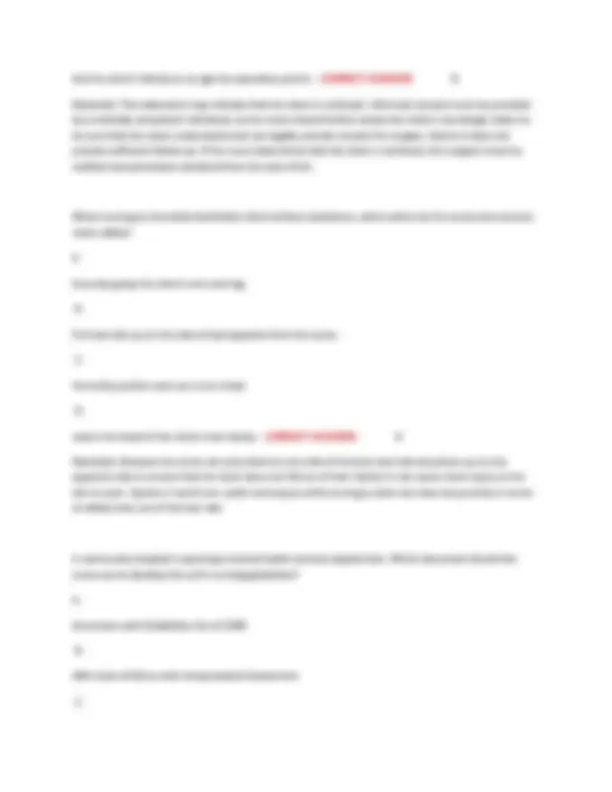
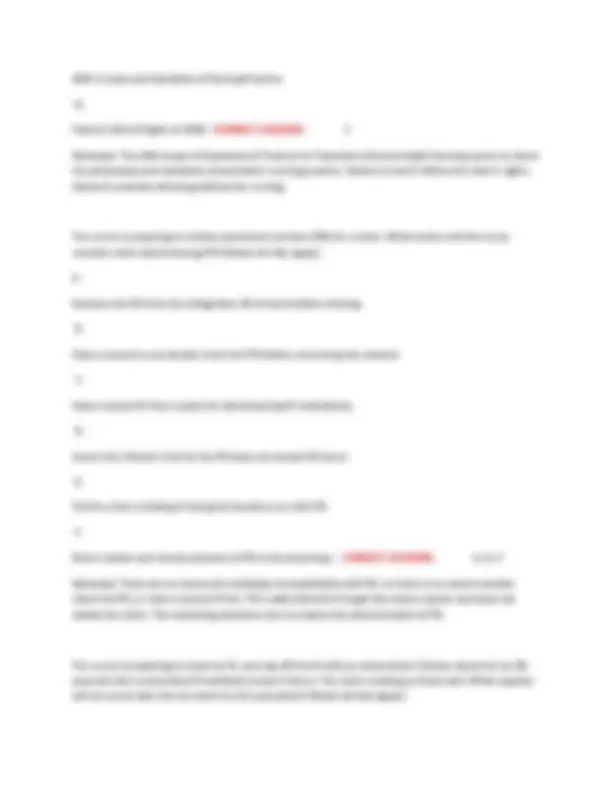
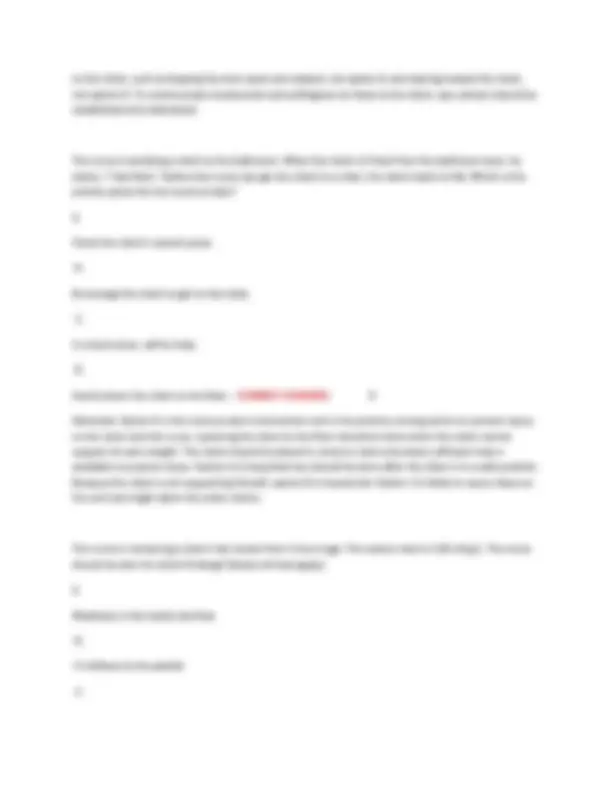
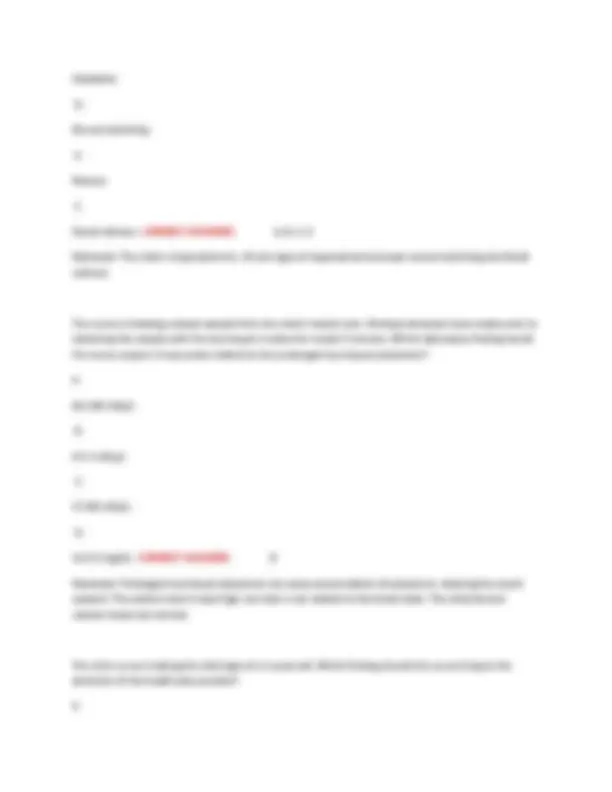
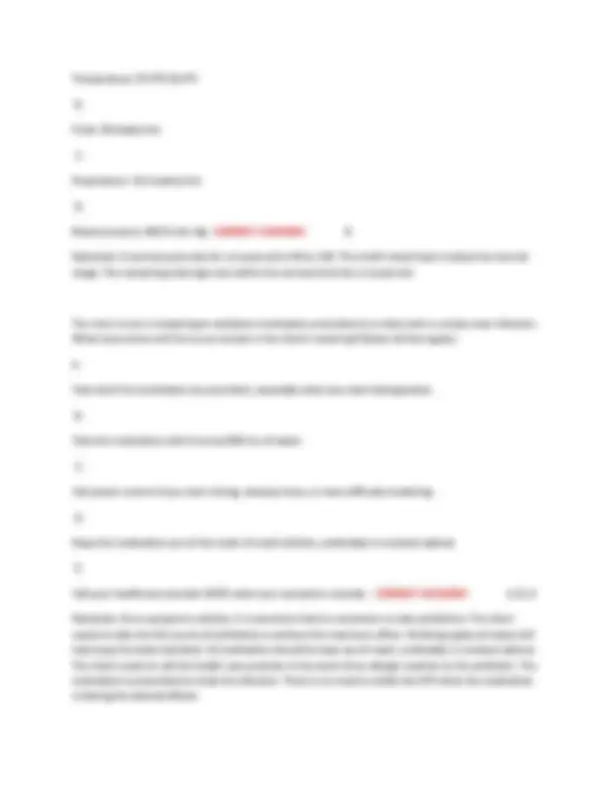
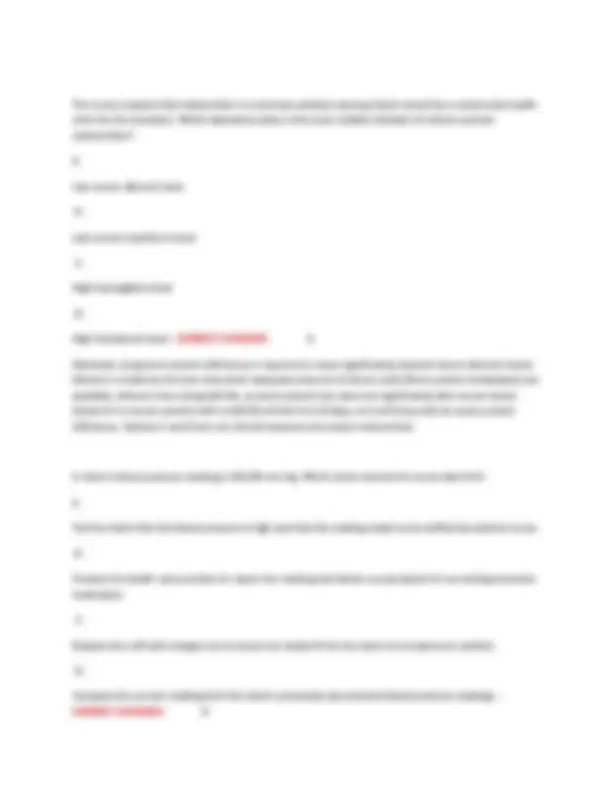
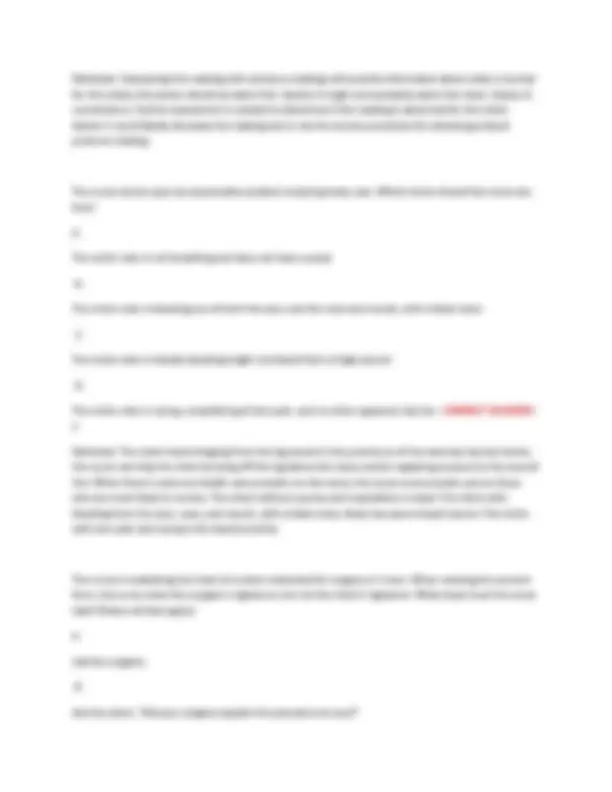
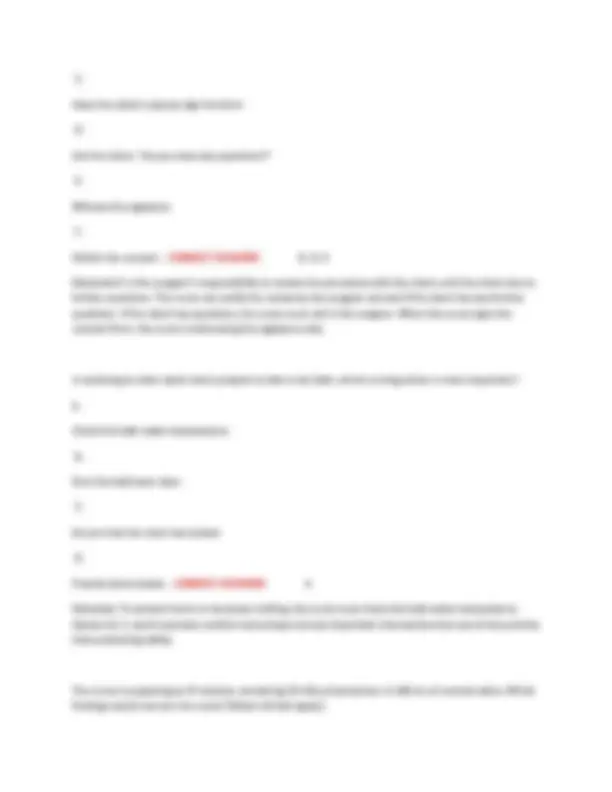
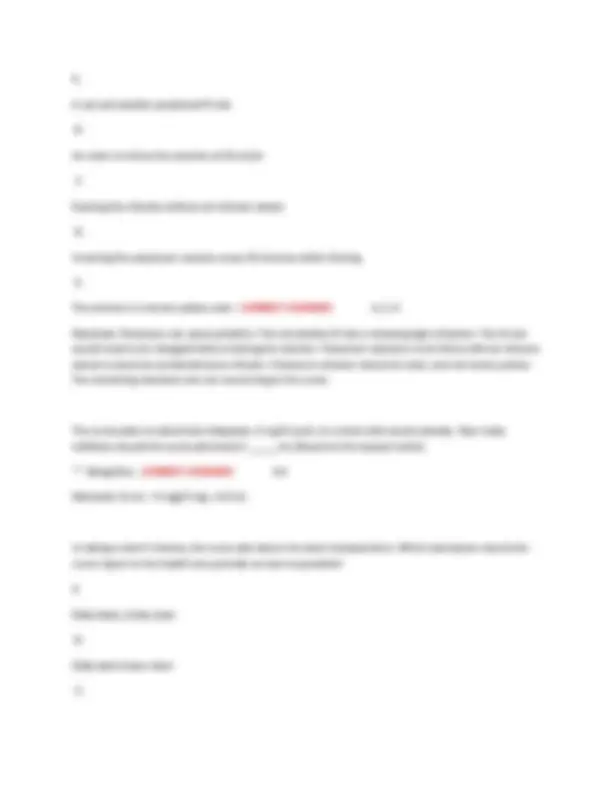
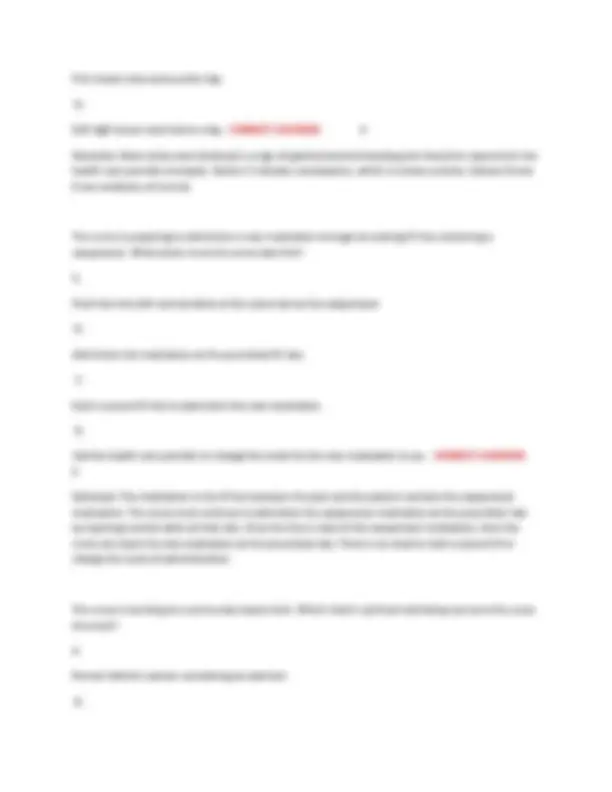
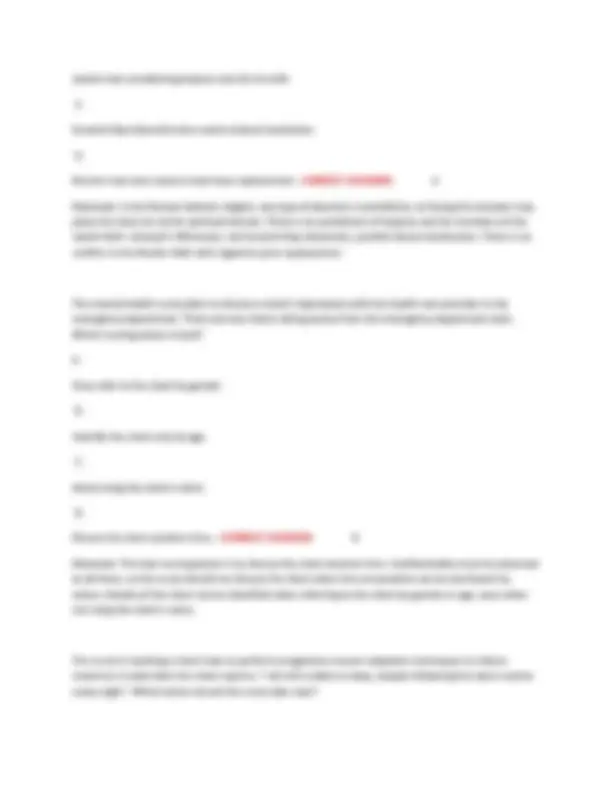
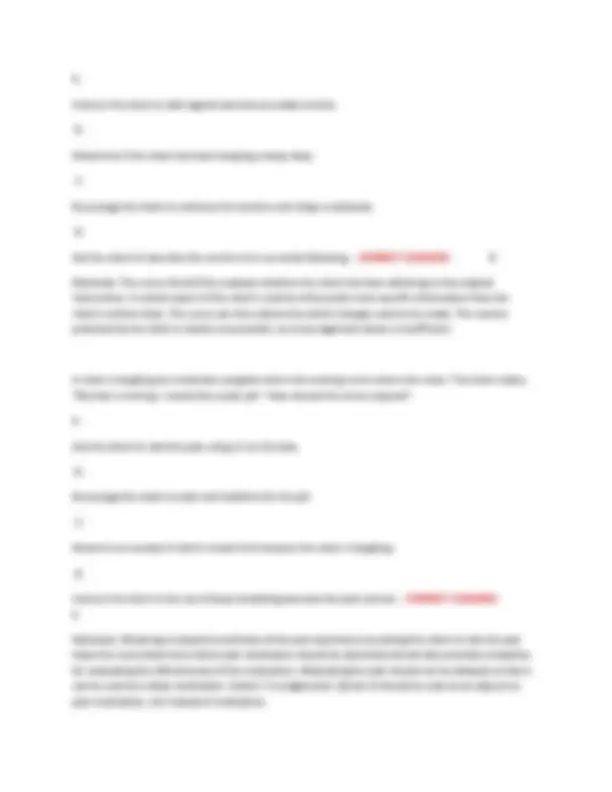
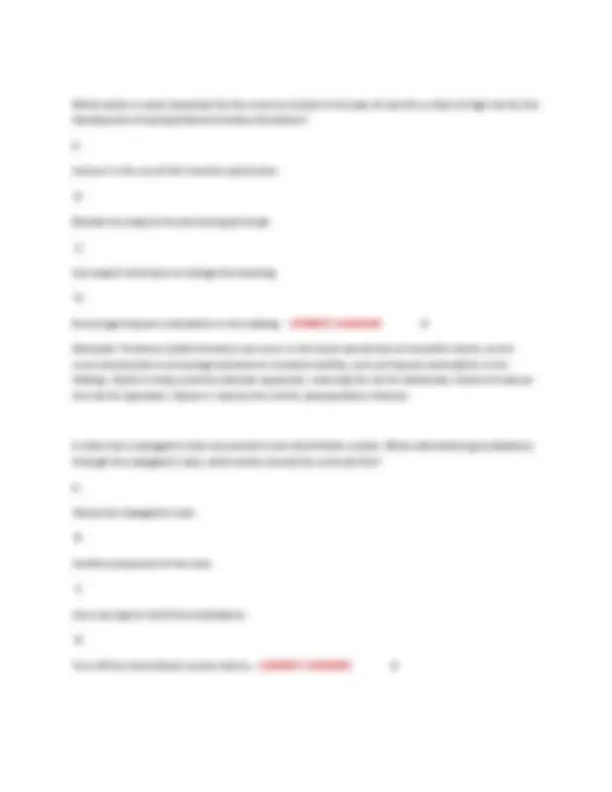
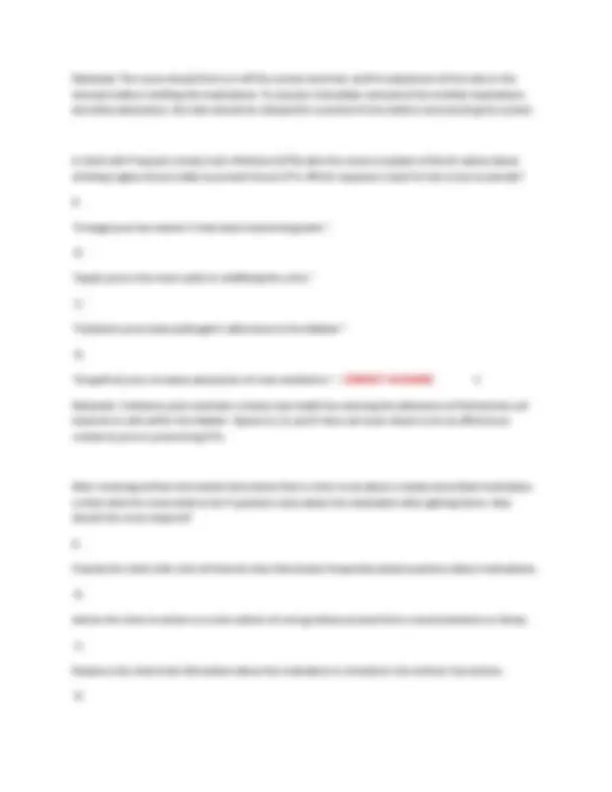
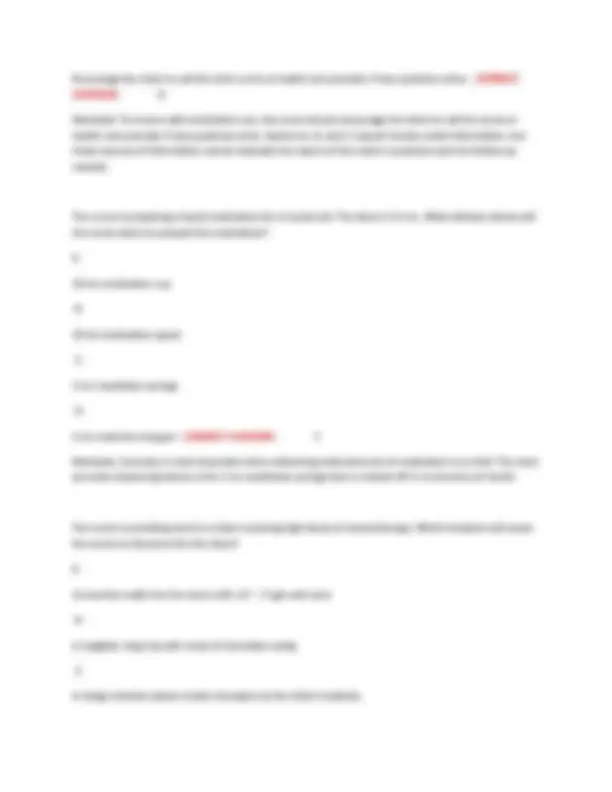

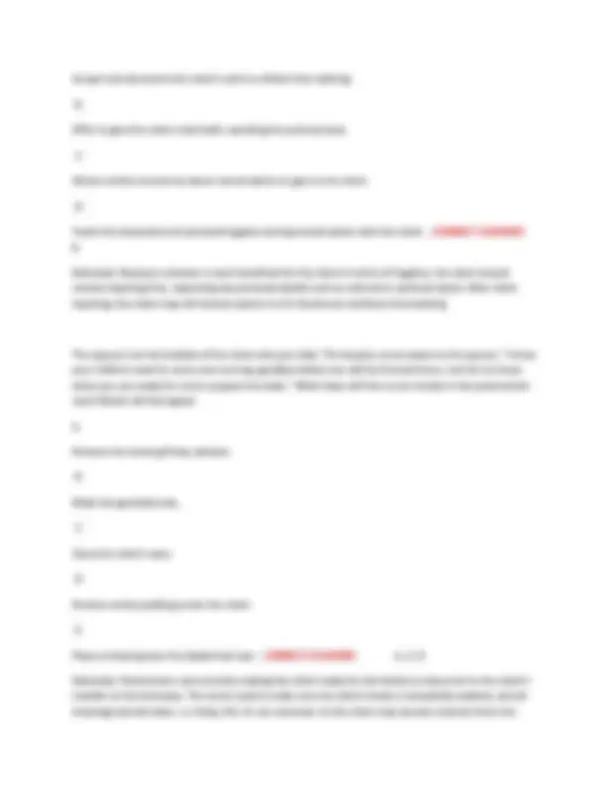
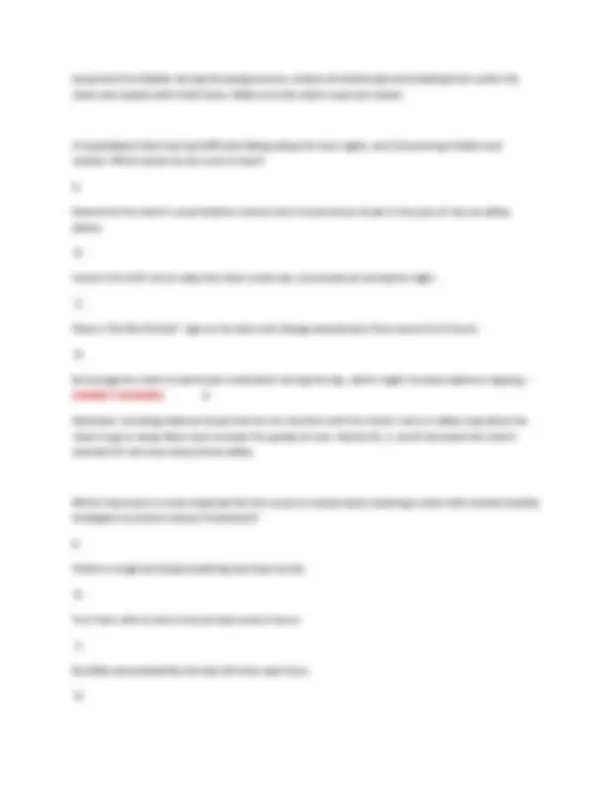
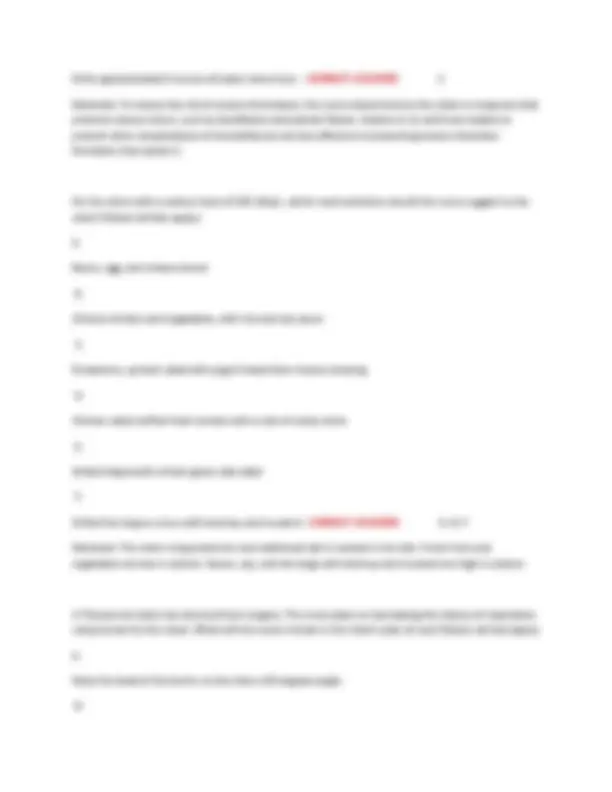
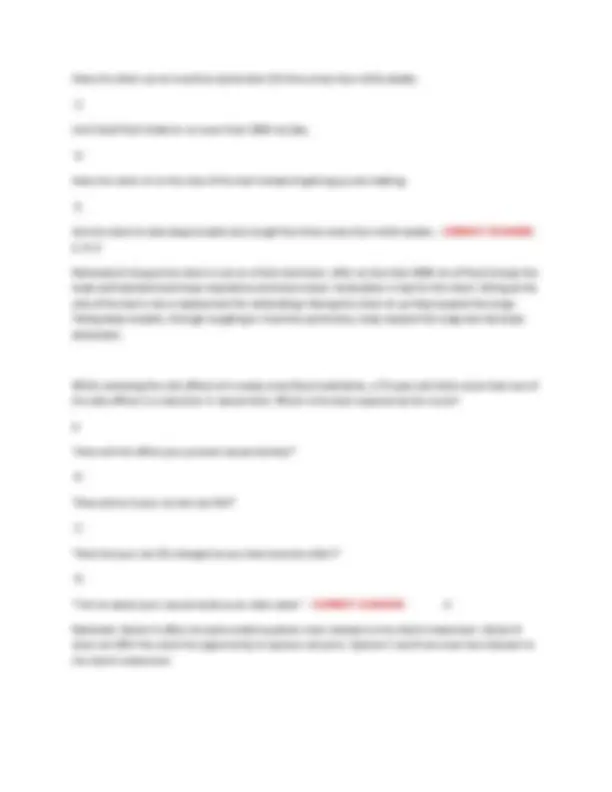
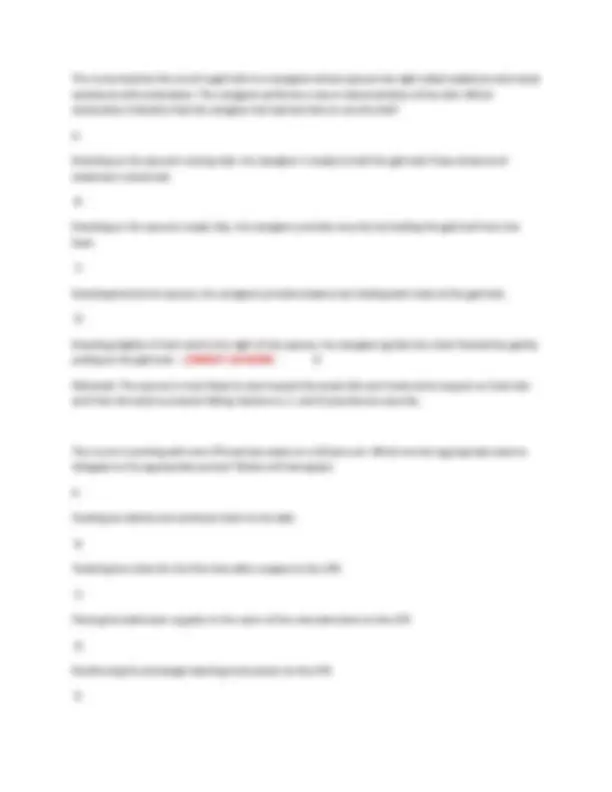
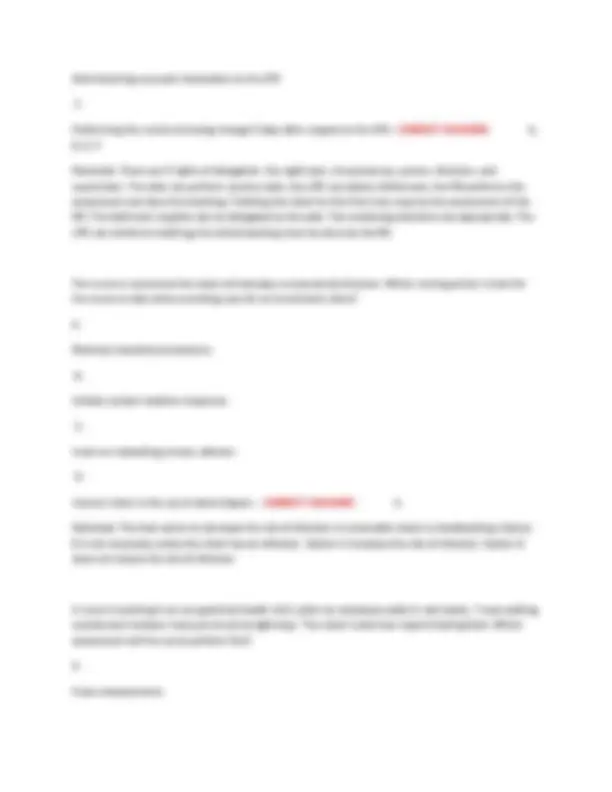
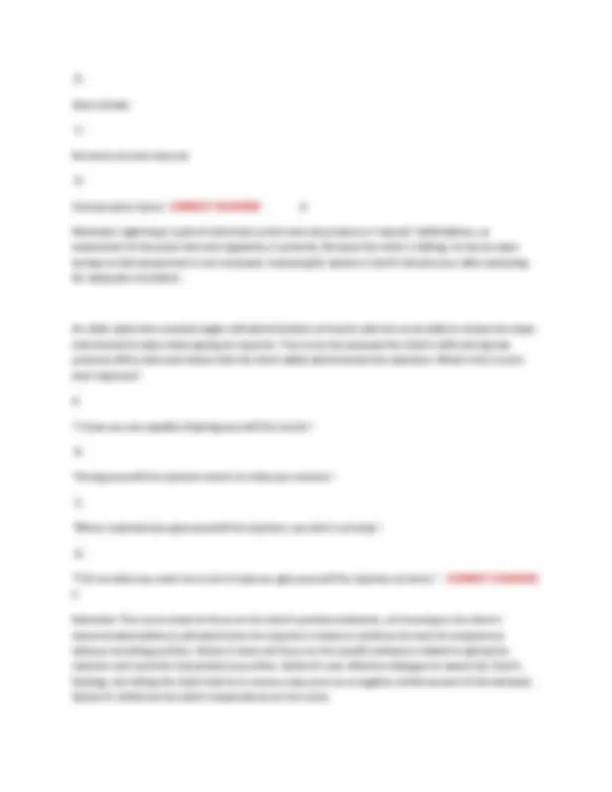

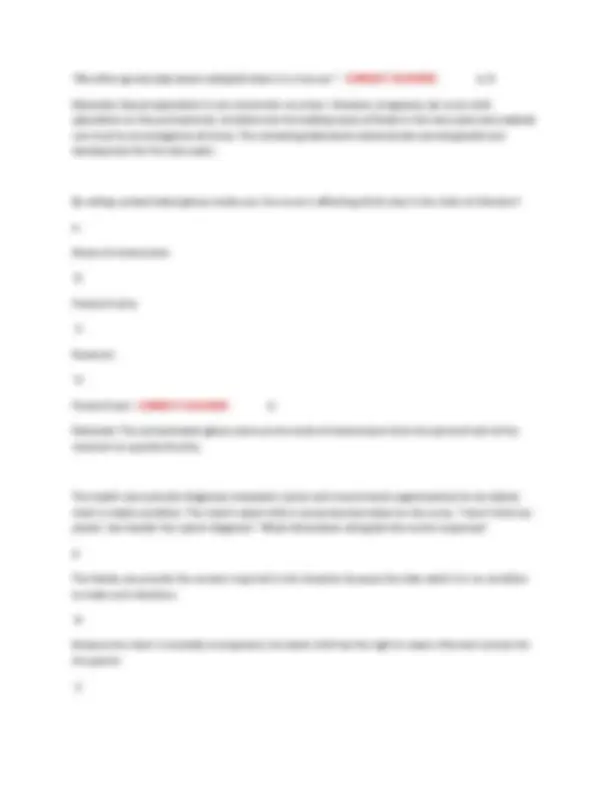
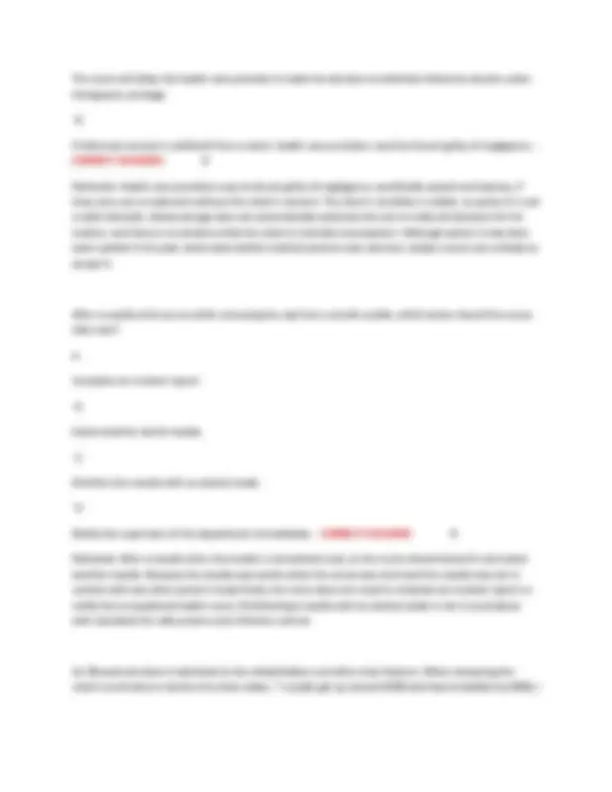
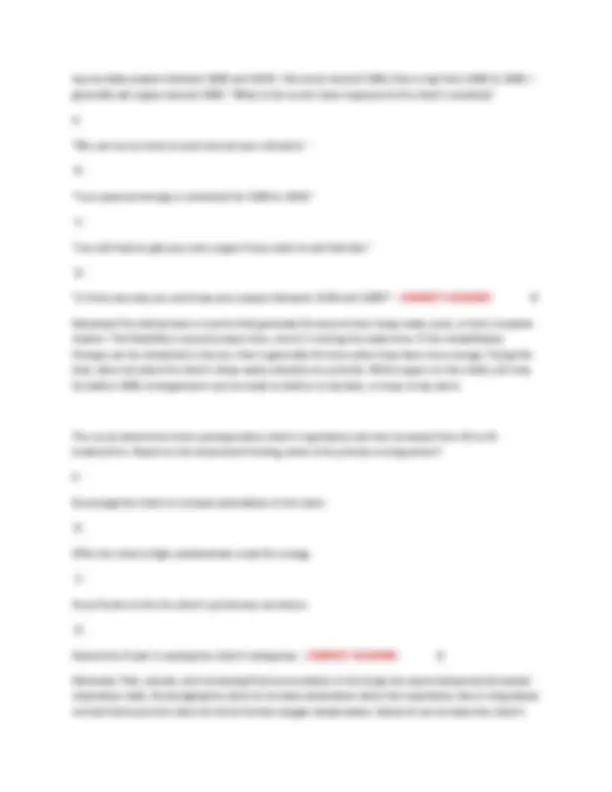
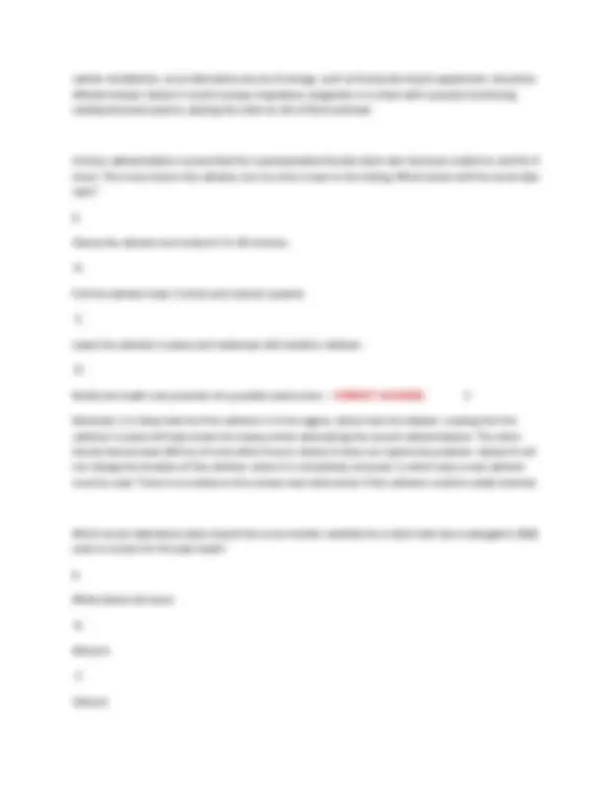
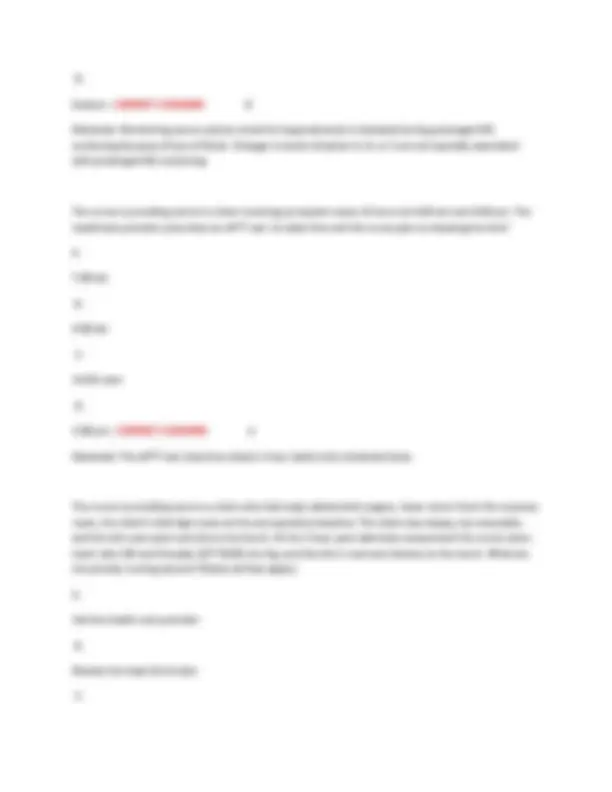
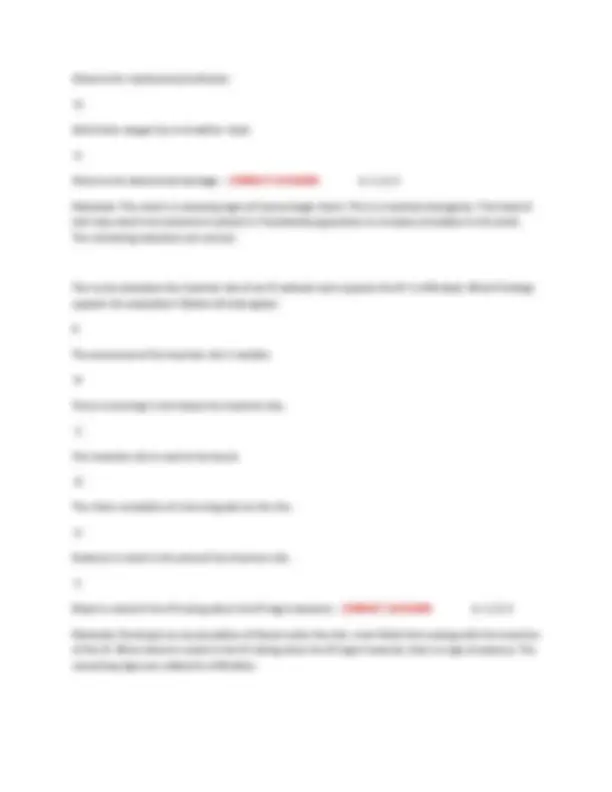
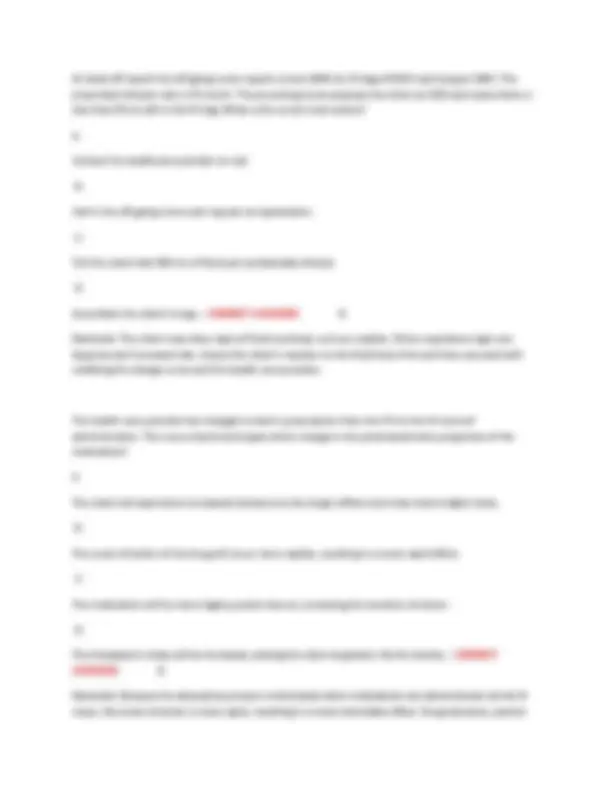
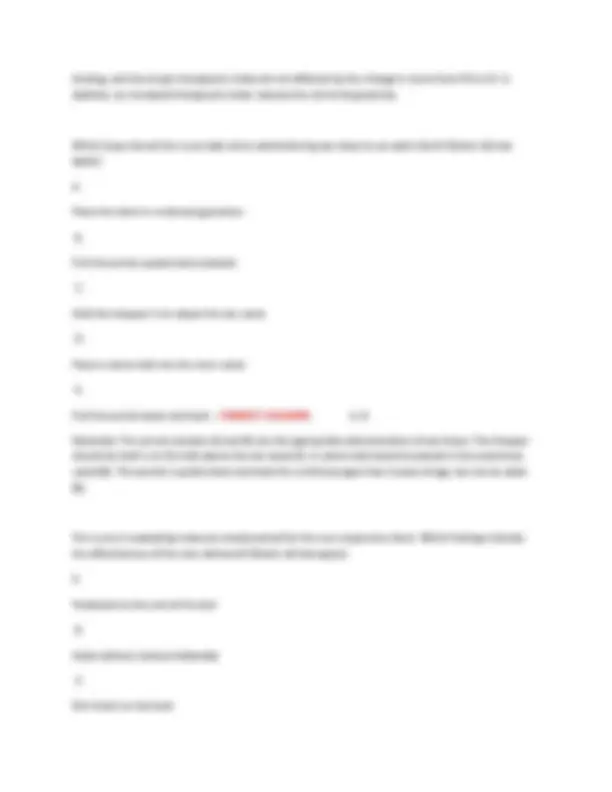
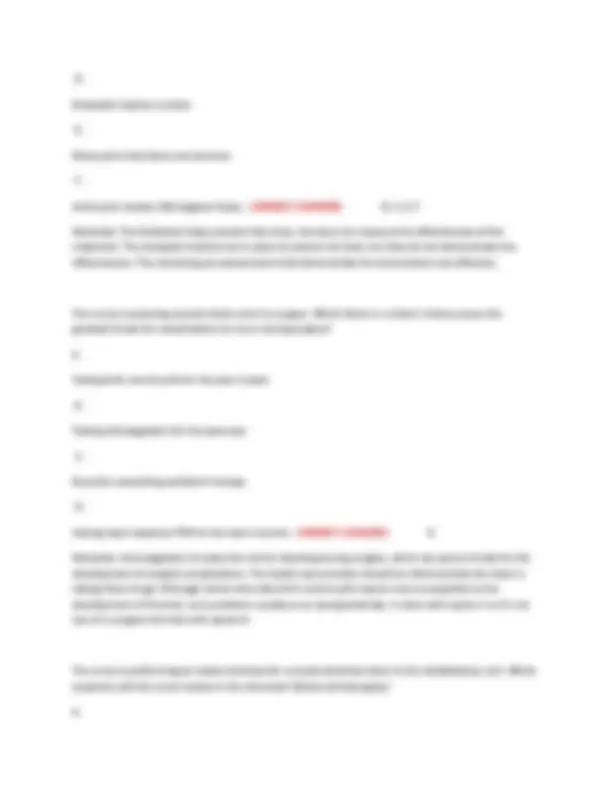
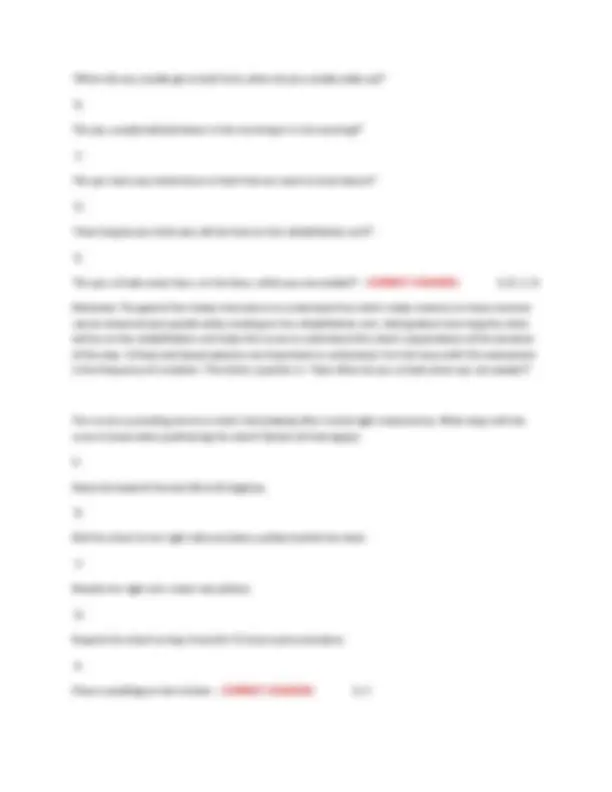
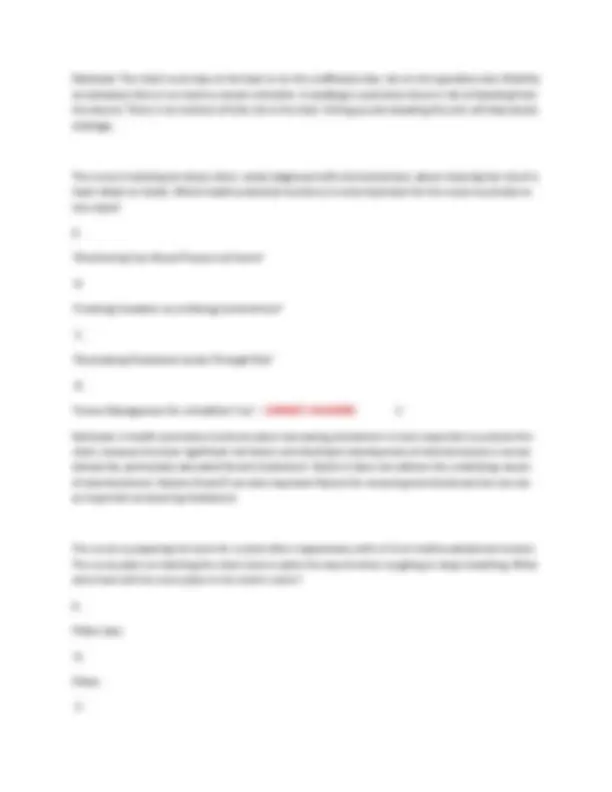
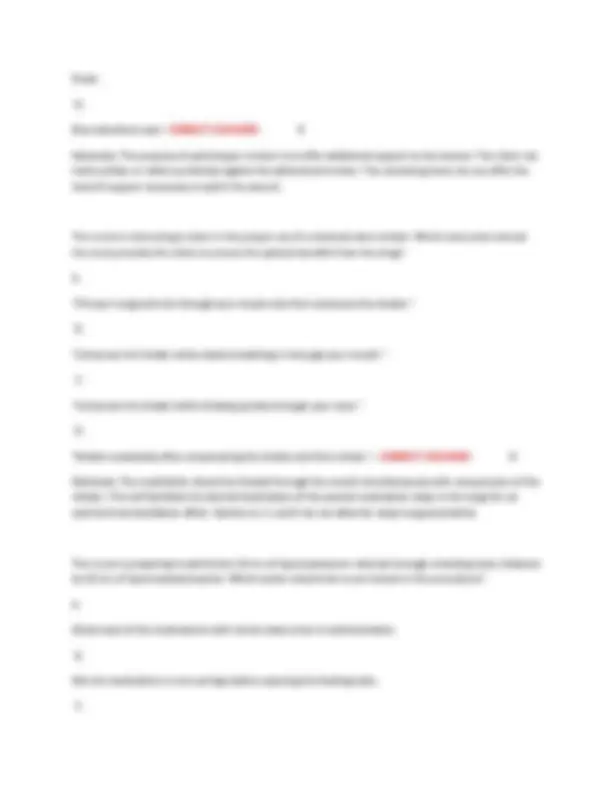
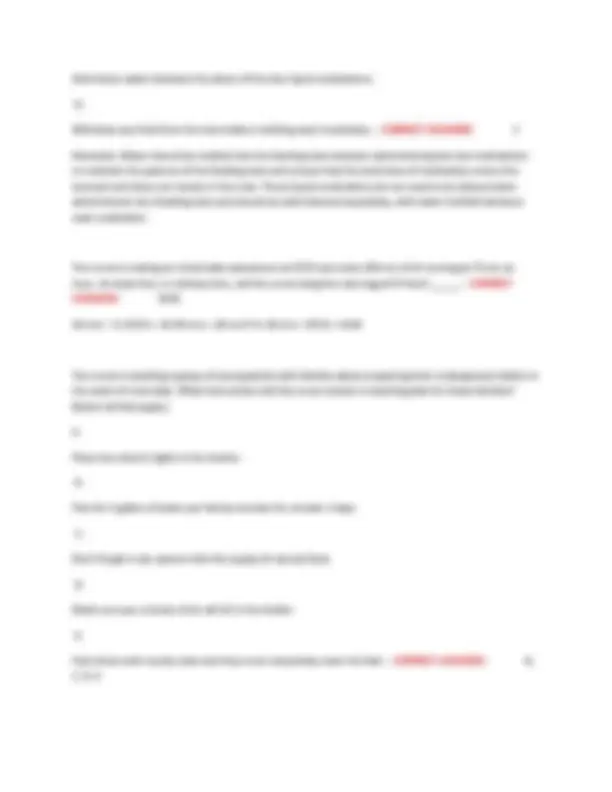
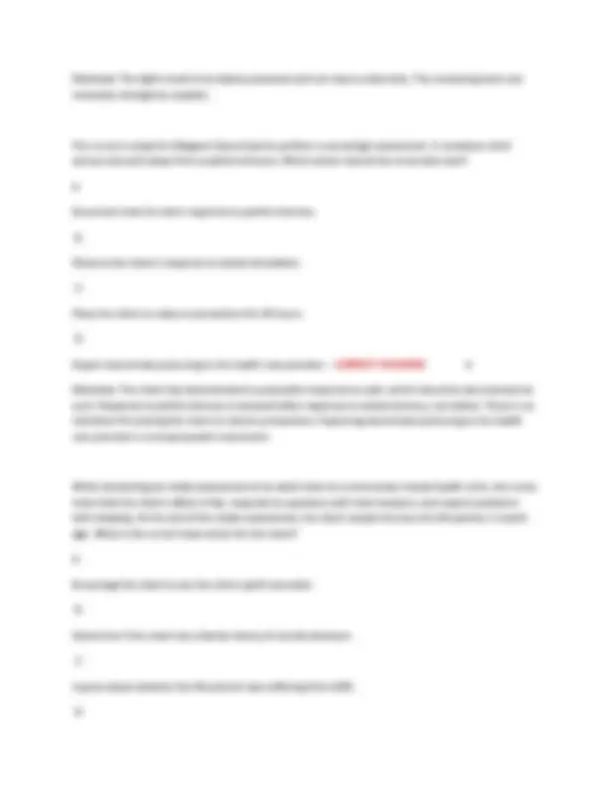
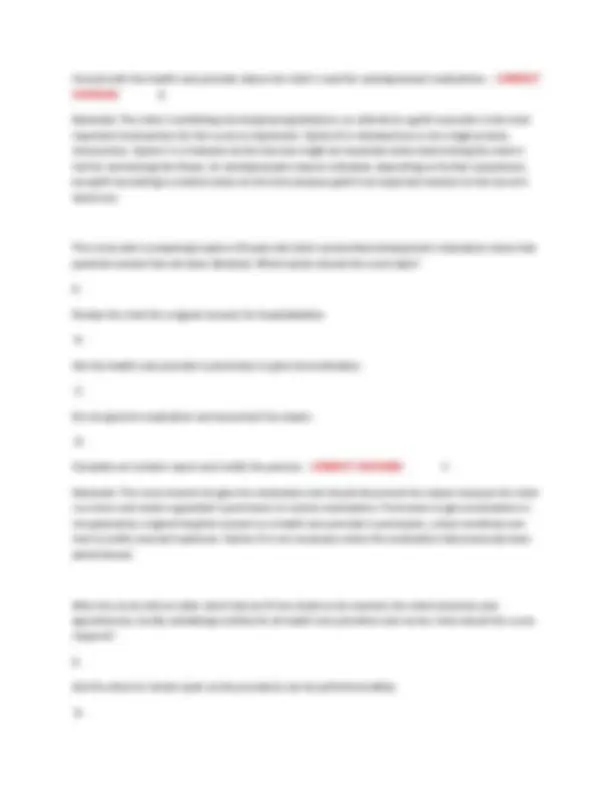
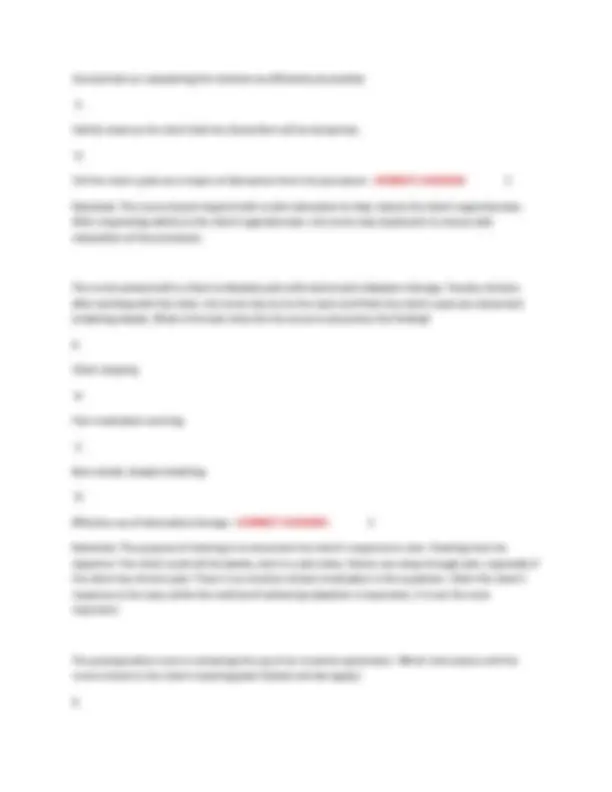
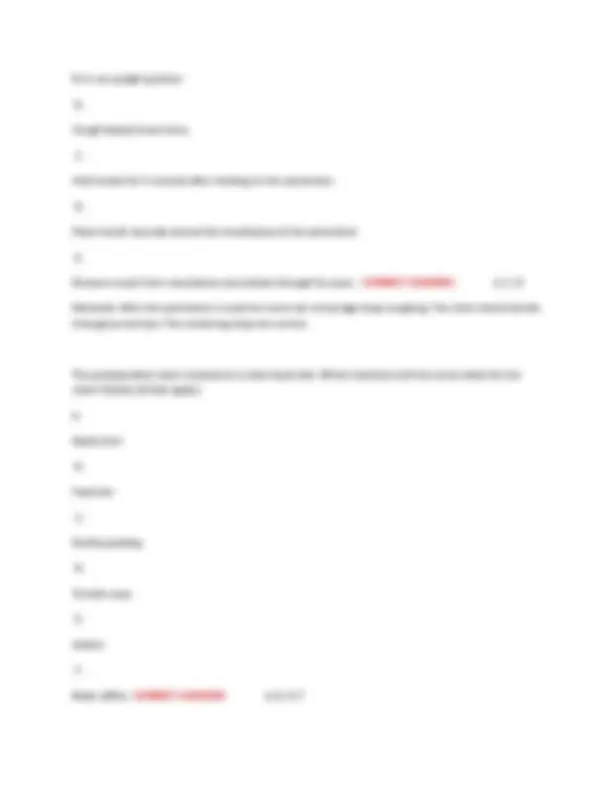
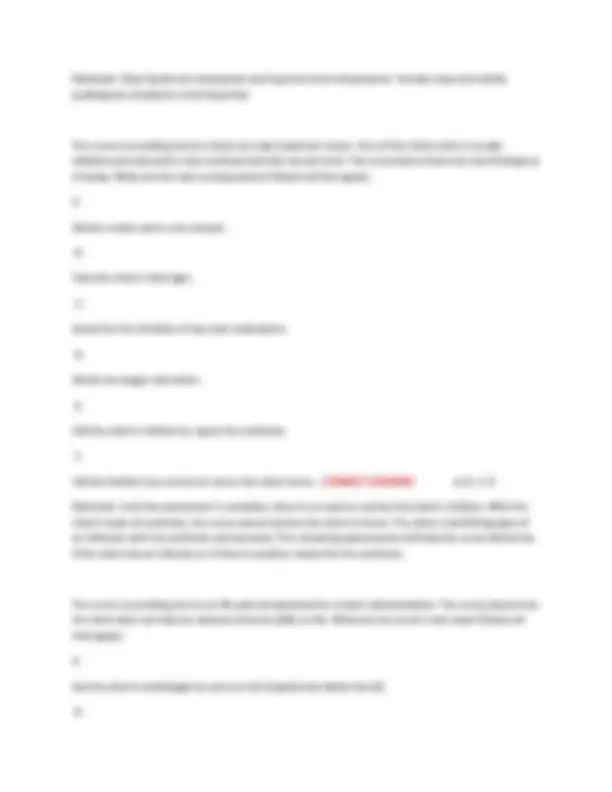
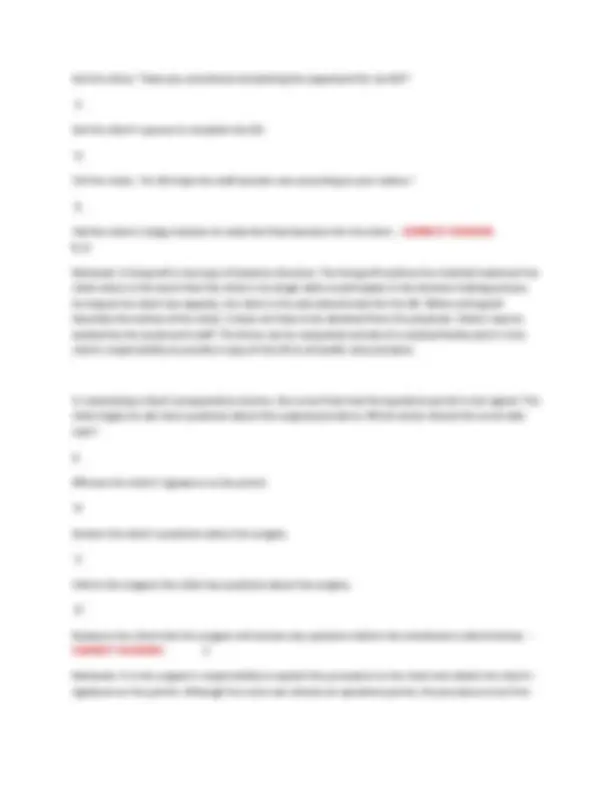
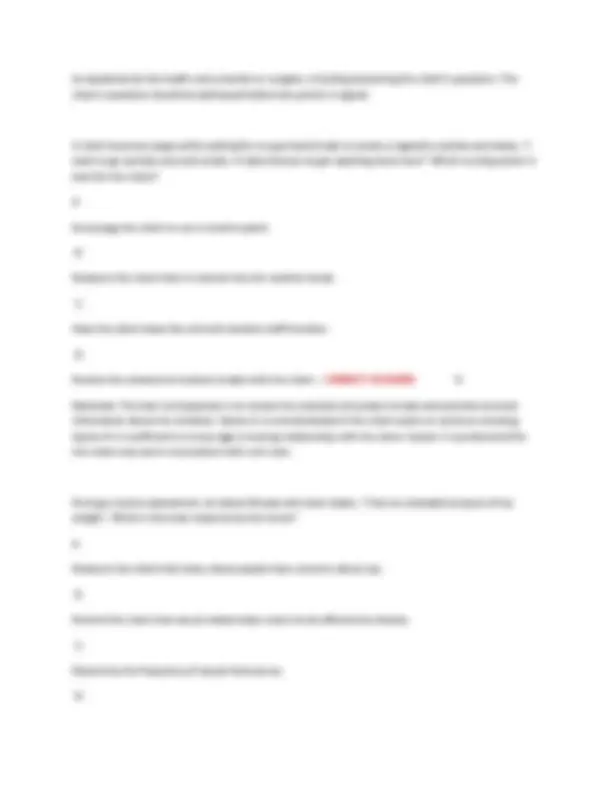
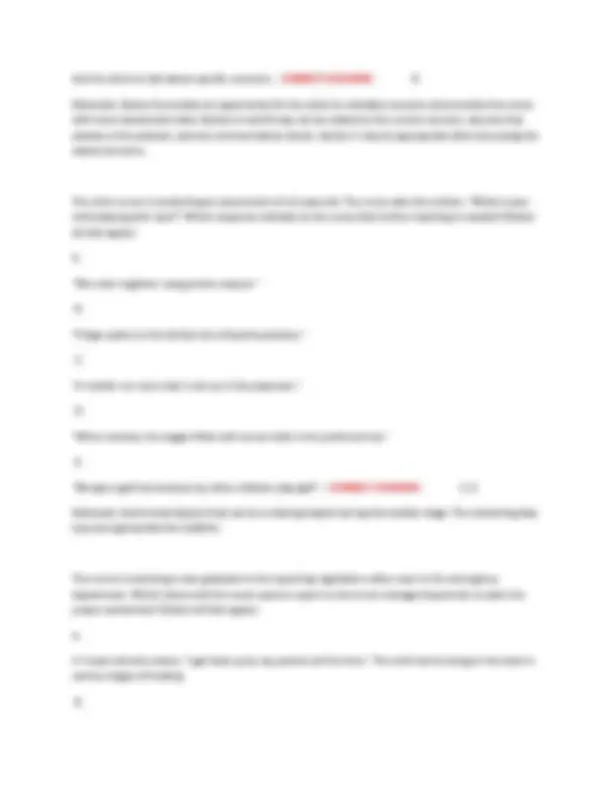
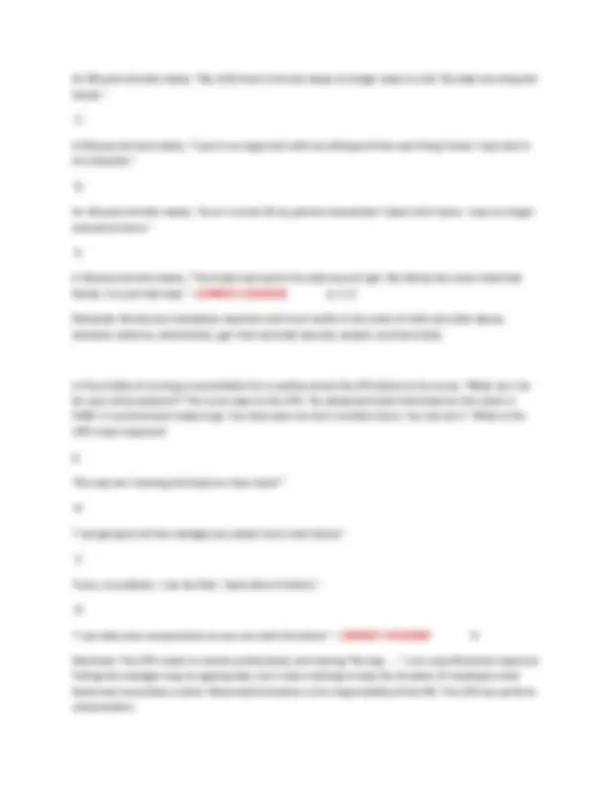
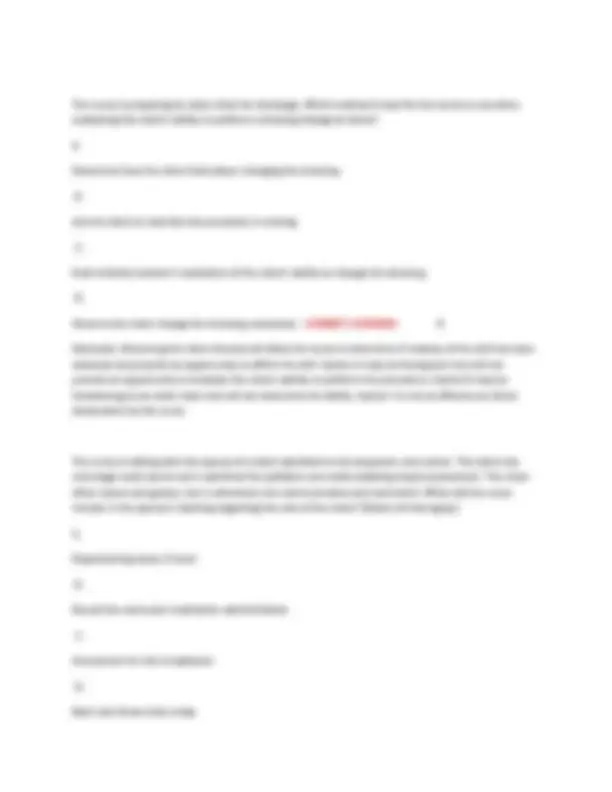
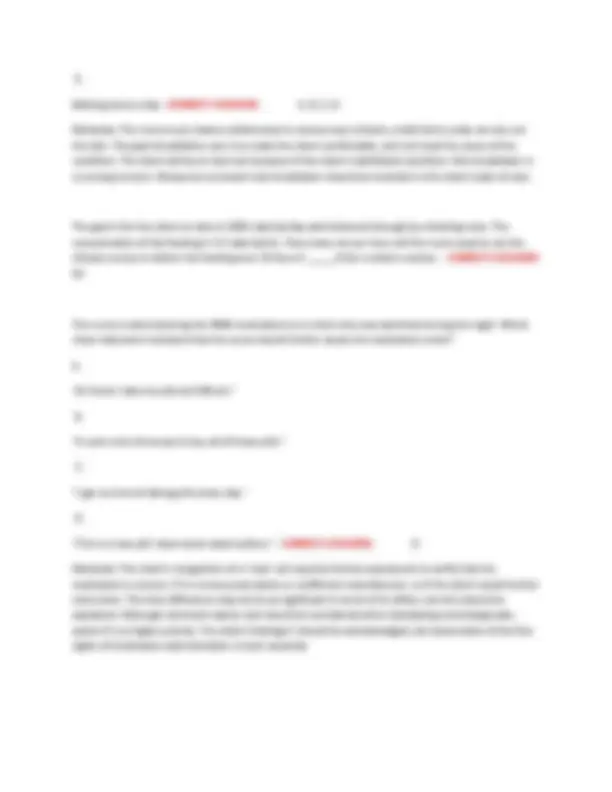
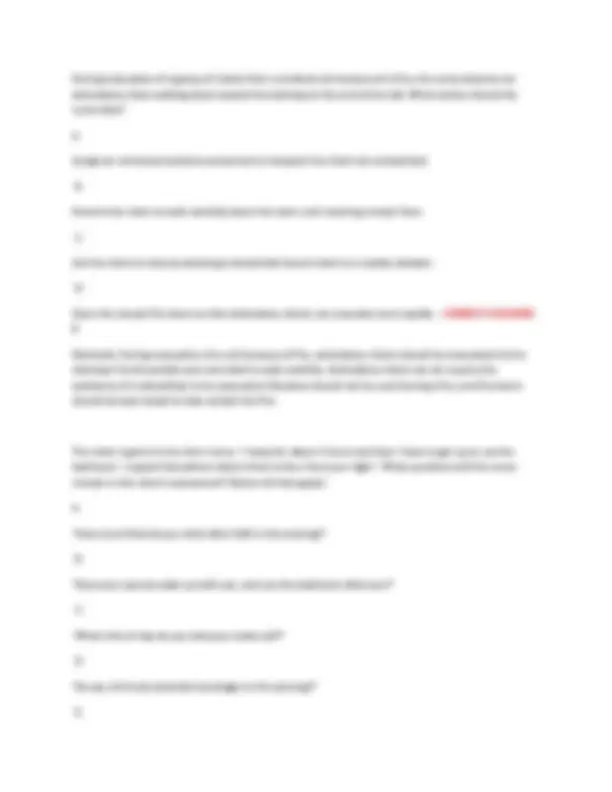
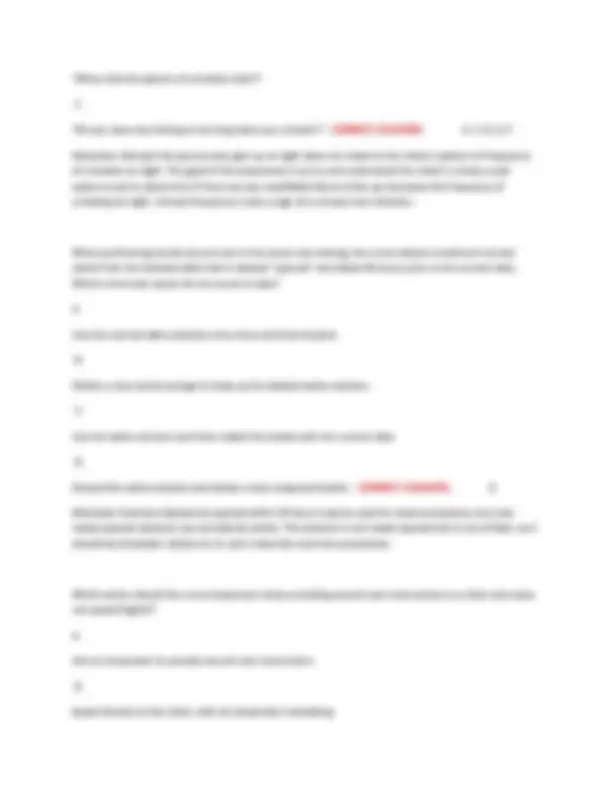

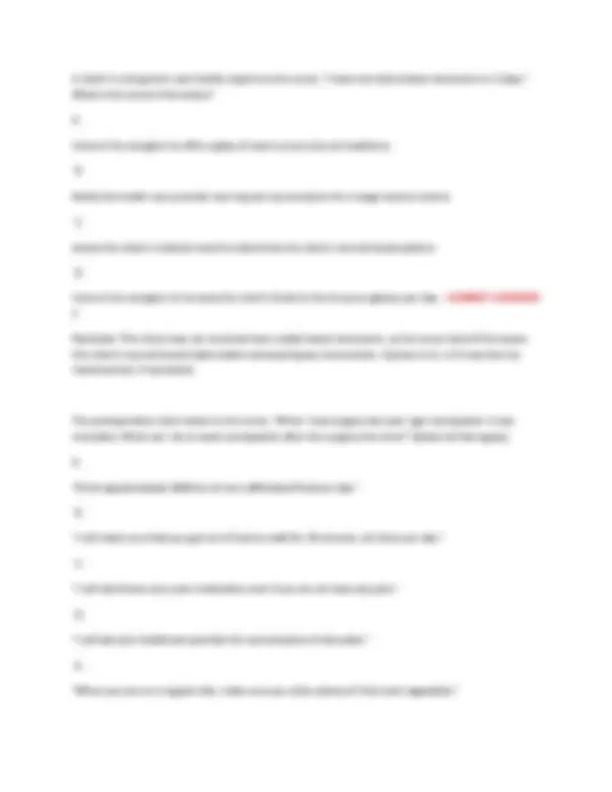
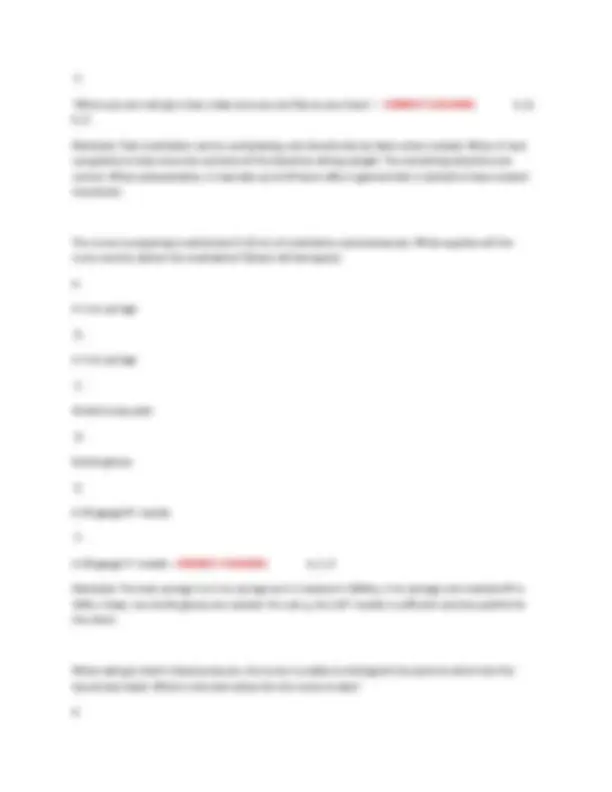
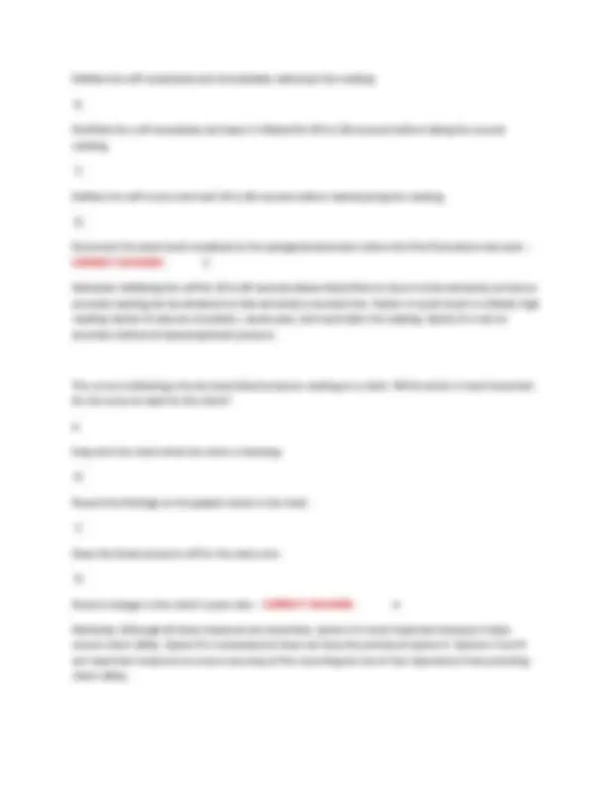
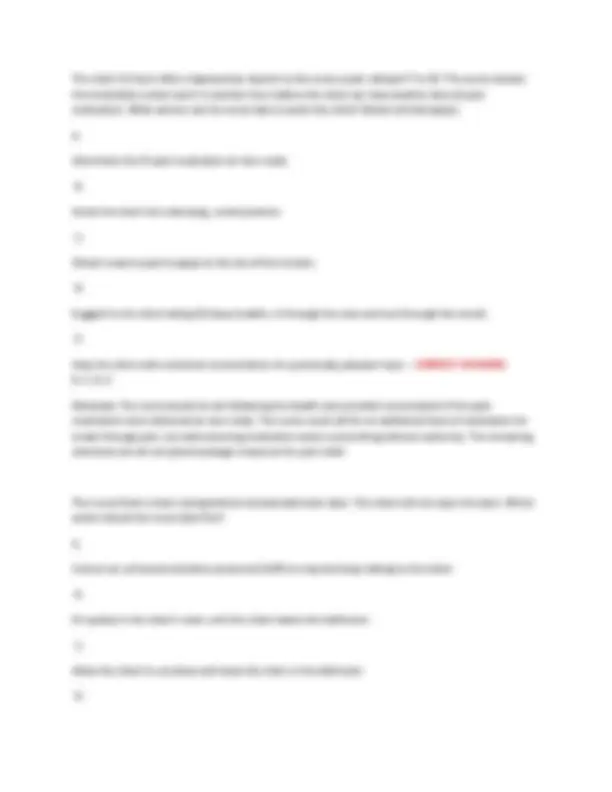
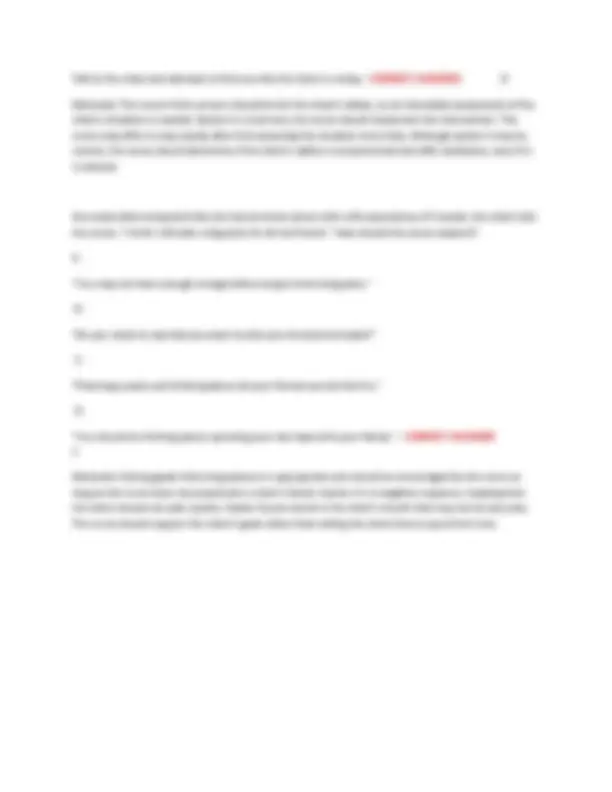


Study with the several resources on Docsity

Earn points by helping other students or get them with a premium plan


Prepare for your exams
Study with the several resources on Docsity

Earn points to download
Earn points by helping other students or get them with a premium plan
Community
Ask the community for help and clear up your study doubts
Discover the best universities in your country according to Docsity users
Free resources
Download our free guides on studying techniques, anxiety management strategies, and thesis advice from Docsity tutors
HESI RN FUNDAMENTALS EXIT EXAM LATEST 2025-2026 ACTUAL EXAM 125QUESTIONS AND CORRECT ANSWERS WITH RATIOANLES (VERIFIED ANSWERS)
Typology: Exams
1 / 71

This page cannot be seen from the preview
Don't miss anything!
































































The nurse is called to the waiting room of a pediatric clinic. The frantic mother states, "I think my 4- month-old baby is choking!" What steps will the nurse take? (Select all that apply.)
A.
Compress the chest once between the nipples with two fingers.
B.
Note any obstruction or absence of breathing.
C.
Deliver five backslaps between the shoulder blades.
D.
Place the infant over the nurse's arm.
E.
Perform a blind finger sweep. - CORRECT ANSWERS B, C, D
Rationale: The fingers are placed at the same location on an infant as chest compressions for CPR; however, the nurse must deliver five chest thrusts, after the five back slaps. Blind sweeps are not used as this action may push the object deeper into the throat. The remaining steps are correct.
Which fluid will the nurse select to administer with the prescribed blood transfusion?
A.
5% Dextrose and water
B.
Normal saline
C.
Lactated Ringers solution
D.
5% Dextrose and lactated ringers - CORRECT ANSWERS B
Rationale: Normal saline solution is the only solution that is compatible with blood.
When assisting a client from the bed to a chair, which procedure is best for the nurse to follow?
A.
Place the chair parallel to the bed, with its back toward the head of the bed and assist the client in moving to the chair.
B.
With the nurse's feet spread apart and knees aligned with the client's knees, stand and pivot the client into the chair.
C.
Assist the client to a standing position by gently lifting upward, underneath the axillae.
D.
Stand beside the client, place the client's arms around the nurse's neck, and gently move the client to the chair. - CORRECT ANSWERS B
Rationale: Option B describes the correct positioning of the nurse and affords the nurse a wide base of support while stabilizing the client's knees when assisting to a standing position. The chair should be placed at a 45-degree angle to the bed, with the back of the chair toward the head of the bed. Clients should never be lifted under the axillae; this could damage nerves and strain the nurse's back. The client should be instructed to use the arms of the chair and should never place his or her arms around the nurse's neck; this places undue stress on the nurse's neck and back and increases the risk for a fall.
How many mL will the nurse document on the client's intake and output record from the items listed? _____ mL
1200 mL water
4 ounce container of gelatin
8 ounces of orange juice
Description of the family's home environment - CORRECT ANSWERS D
Rationale: School-age children often resist bedtime. The nurse should begin by assessing the environment of the home to determine factors that may not be conducive to the establishment of bedtime rituals that promote sleep. Option A often causes daytime fatigue rather than resistance to going to sleep. Option B is unlikely to provide useful data. The nurse cannot determine option C.
The nurse identifies a potential for infection in a client with partial-thickness (second-degree) and full- thickness (third-degree) burns. What action has the highest priority in decreasing the client's risk of infection?
A.
Administration of plasma expanders
B.
Use of careful handwashing technique
C.
Application of a topical antibacterial cream
D.
Limiting visitors to the client with burns - CORRECT ANSWERS B
Rationale: Careful handwashing technique is the single most effective intervention for the prevention of contamination to all clients. Option A reverses the hypovolemia that initially accompanies burn trauma but is not related to decreasing the proliferation of infective organisms. Options C and D are recommended by various burn centers as possible ways to reduce the chance of infection. Option B is a proven technique to prevent infection.
The nurse assesses a 2-year-old who is admitted for dehydration and finds that the peripheral IV rate by gravity has slowed, even though the venous access site is healthy. What should the nurse do next?
A.
Apply a warm compress proximal to the site.
B.
Check for kinks in the tubing and raise the IV pole.
C.
Adjust the tape that stabilizes the needle.
D.
Flush with normal saline and recount the drop rate. - CORRECT ANSWERS B
Rationale: The nurse should first check the tubing and height of the bag on the IV pole, which are common factors that may slow the rate. Gravity infusion rates are influenced by the height of the bag, tubing clamp closure or kinks, needle size or position, fluid viscosity, client blood pressure (crying in the pediatric client), and infiltration. Venospasm can slow the rate and often responds to warmth over the vessel, but the nurse should first adjust the IV pole height. The nurse may need to adjust the stabilizing tape on a positional needle or flush the venous access with normal saline, but less invasive actions should be implemented first.
The nurse manager of a skilled nursing (chronic care) unit is instructing UAPs on ways to prevent complications of immobility. Which action should be included in this instruction?
A.
Perform range-of-motion exercises to prevent contractures.
B.
Decrease the client's fluid intake to prevent diarrhea.
C.
Massage the client's legs to reduce embolism occurrence.
D.
Turn the client from side to back every shift. - CORRECT ANSWERS A
Rationale: Performing range-of-motion exercises is beneficial in reducing contractures around joints. Options B, C, and D are all potentially harmful practices that place the immobile client at risk of complications.
The nurse administered 10 mg of diazepam to the preoperative client. What steps will the nurse take next? (Select all that apply.)
A nurse stops at a motor vehicle collision site to render aid until the emergency personnel arrive and applies pressure to a groin wound that is bleeding profusely. Later the client has to have the leg amputated and sues the nurse for malpractice. Which statement reflects the likely outcome for the nurse?
A.
The Patient's Bill of Rights protects clients from malicious intents, so the nurse could lose the case.
B.
The lawsuit may be settled out of court, but the nurse's license is likely to be revoked.
C.
There will be no judgment against the nurse, whose actions are protected under the Good Samaritan Act.
D.
The client will win because the four elements of negligence (duty, breach, causation, and damages) can be proved. - CORRECT ANSWERS C
Rationale: The Good Samaritan Act protects health care professionals who practice in good faith and provide reasonable care from malpractice claims, regardless of the client outcome. Although the Patient's Bill of Rights protects clients, this nurse is protected by the Good Samaritan Act. The state Board of Nursing has no reason to revoke a registered nurse's license unless there was evidence that actions taken in the emergency were not done in good faith or that reasonable care was not provided. All four elements of malpractice were not shown.
An older client who had abdominal surgery 3 days earlier was given a barbiturate for sleep and is now requesting to go to the bathroom. What is the priority nursing action for this client?
A.
Assist the client to walk to the bathroom and do not leave the client alone.
B.
Request that the UAP assist the client onto a bedpan.
C.
Ask if the client needs to have a bowel movement or void.
Assess the client's bladder to determine if the client needs to urinate. - CORRECT ANSWERS A
Rationale: Barbiturates cause central nervous system (CNS) depression, and individuals taking these medications are at greater risk for falls. The nurse should assist the client to the bathroom. A bedpan is not necessary as long as safety is ensured. Whether the client needs to void or have a bowel movement, option C is irrelevant in terms of meeting this client's safety needs. There is no indication that this client cannot voice her or his needs, so assessment of the bladder is not needed.
The nurse is planning care for a client with an indwelling urinary catheter. Which nursing action has the highest priority?
A.
Assist the client with daily cleansing.
B.
Tell the client that incontinence happens with aging.
C.
Offer 200 mL of fluid every 2 hours while awake.
D.
Take the client's temperature every 4 hours. - CORRECT ANSWERS D
Rationale: Indwelling urinary catheters are a major source of infection. Option A is a problem that may develop from having an indwelling catheter. Option B may or may not be true for the client. Option C is not affected by an indwelling catheter.
When bathing an uncircumcised boy older than 3 years, which action should the nurse take?
A.
Remind the child to clean his genital area.
B.
Defer perineal care because of the child's age.
C.
Dorsal side of the right wrist
D.
Right upper extremity - CORRECT ANSWERS B
Rationale: The cephalic vein is large and superficial and identifies the anatomic name of the vein that is accessed, which should be included in the documentation. The basilic vein of the arm is used for IV access, not the brachial vein, which is too deep to be accessed for IV infusion. Although veins on the dorsal side of the right wrist are visible, they are fragile and using them would be painful, so they are not recommended for IV access. Option D is not specific enough for documenting the location of the IV access.
The nurse transcribes the postoperative prescriptions for a client who returns to the unit following surgery and notes that an antihypertensive medication that was prescribed preoperatively is not listed. Which action should the nurse take?
A.
Consult with the pharmacist about the need to continue the medication.
B.
Administer the antihypertensive medication as prescribed preoperatively.
C.
Withhold the medication until the client is fully alert and vital signs are stable.
D.
Contact the health care provider to renew the prescription for the medication. - CORRECT ANSWERS D
Rationale: Medications prescribed preoperatively must be renewed postoperatively, so the nurse should contact the health care provider if the antihypertensive medication is not included in the postoperative prescriptions. The pharmacist does not prescribe medications or renew prescriptions. The nurse must have a current prescription before administering any medications.
When emptying 350 mL of pale yellow urine from a client's urinal, the nurse notes that this is the first time the client has voided in 4 hours. Which action should the nurse take next?
Record the amount on the client's fluid output record.
B.
Encourage the client to increase oral fluid intake.
C.
Notify the health care provider of the findings.
D.
Palpate the client's bladder for distention. - CORRECT ANSWERS A
Rationale: The amount and appearance of the client's urine output is within normal limits, so the nurse should record the output, but no additional action is needed.
The client states to the nurse, "This medication makes my mouth so dry." What are the nurse's suggestions to quench the client's thirst? (Select all that apply.)
A.
Drink 2, 8 ounce glasses of lemon-lime soda every day.
B.
Infuse your water with fresh citrus fruits to quench your thirst.
C.
Freeze strawberries and water together in popsicle mold.
D.
Add ginger ale to your daily glass of juice every day.
E.
Keep a few pieces of hard candy with you to suck on. - CORRECT ANSWERS B, C, E
Rationale: Sodas do not tend to be thirst quenching because of the amount of sugar in them that draws fluid into the GI system. Citrus infused water quenches thirst, as does consuming frozen liquids. Hard candy can produce moisture in the mouth.
The nurse is preparing to administer a bolus tube feeding. What steps must the nurse include prior to administering the feeding? (Select all that apply.)
A.
Aspirate the stomach contents.
B.
Assess bowel sounds.
C.
Position the client in semi-Fowler's position.
D.
Irrigate the lumen after the contents are replaced.
E.
Warm the feeding to room temperature.
F.
Assess the pH of the stomach contents. - CORRECT ANSWERS A, B, E, F
Rationale: The client needs to be in high Fowler's position to decrease the risk of aspiration. Irrigation of the lumen is only necessary if there is an obstruction. The contents were replaced, so there is no suspicion of obstruction. The remaining steps are correct.
Ten minutes after signing an operative permit for a fractured hip, an older client states, "The aliens will be coming to get me soon!" and falls asleep. Which action should the nurse take next?
A.
Make the client comfortable and allow the client to sleep.
B.
Assess the client's neurologic status.
C.
Notify the surgeon about the comment.
D.
Ask the client's family to co-sign the operative permit. - CORRECT ANSWERS B
Rationale: This statement may indicate that the client is confused. Informed consent must be provided by a mentally competent individual, so the nurse should further assess the client's neurologic status to be sure that the client understands and can legally provide consent for surgery. Option A does not provide sufficient follow-up. If the nurse determines that the client is confused, the surgeon must be notified and permission obtained from the next of kin.
When turning an immobile bedridden client without assistance, which action by the nurse best ensures client safety?
A.
Securely grasp the client's arm and leg.
B.
Put bed rails up on the side of bed opposite from the nurse.
C.
Correctly position and use a turn sheet.
D.
Lower the head of the client's bed slowly. - CORRECT ANSWERS B
Rationale: Because the nurse can only stand on one side of the bed, bed rails should be up on the opposite side to ensure that the client does not fall out of bed. Option A can cause client injury to the skin or joint. Options C and D are useful techniques while turning a client but have less priority in terms of safety than use of the bed rails.
A community hospital is opening a mental health services department. Which document should the nurse use to develop the unit's nursing guidelines?
A.
Americans with Disabilities Act of 1990
B.
ANA Code of Ethics with Interpretative Statements
C.
A 16 gauge IV catheter
B.
Normal saline in a 10 mL syringe
C.
Clear plastic sterile bandage
D.
Skin preparation antiseptic swab
E.
1000 mL bag of normal saline - CORRECT ANSWERS B, C, D
Rationale: Items not needed to insert an IV for intermittent antibiotic therapy for an 80-year-old are a 16 gauge intracath; the intracath is too large. Large bore intracaths are for rapid infusions. A small bag of NS, e.g. 250 mL, will be needed to flush the line. The remaining items are needed to start an IV.
The nurse is instructing a client with cholecystitis regarding diet choices. Which meal best meets the dietary needs of this client?
A.
Steak, baked beans, and a salad
B.
Broiled fish, green beans, and an apple
C.
Pork chops, macaroni and cheese, and grapes
D.
Avocado salad, milk, and angel food cake - CORRECT ANSWERS B
Rationale: Clients with cholecystitis (inflammation of the gallbladder) should follow a low-fat diet, such as option B. Option A is a high-protein diet, and options C and D contain high-fat foods, which are contraindicated for this client.
A 65-year-old client who attends an adult daycare program and is wheelchair mobile has redness in the sacral area. Which instruction is most important for the nurse to provide?
A.
"Take a vitamin supplement tablet once a day."
B.
"Change positions in the chair frequently"
C.
"Increase daily intake of water or other oral fluids."
D.
"Purchase a newer model wheelchair." - CORRECT ANSWERS B
Rationale: The most important teaching is to change positions frequently because pressure is the most significant factor related to the development of pressure ulcers. Increased vitamin and fluid intake may also be beneficial and promote healing and reduce further risk. Option D is an intervention of last resort because this will be very expensive for the client.
Which nonverbal action should the nurse implement to demonstrate active listening?
A.
Sit facing the client.
B.
Cross arms and legs.
C.
Avoid eye contact.
D.
Lean back in the chair. - CORRECT ANSWERS A
Rationale: Active listening is conveyed using attentive verbal and nonverbal communication techniques. To facilitate therapeutic communication and attentiveness, the nurse should sit facing the client, which lets the client know that the nurse is there to listen. Active listening skills include postures that are open
Headache
D.
Muscle twitching
E.
Nausea
F.
Facial redness - CORRECT ANSWERS A, B, C, E
Rationale: The client is hyponatremic. All are signs of hyponatremia except muscle twitching and facial redness.
The nurse is drawing a blood sample from the client's basilic vein. Multiple attempts were made prior to obtaining the sample with the tourniquet in place for nearly 5 minutes. Which laboratory finding would the nurse suspect is inaccurate related to the prolonged tourniquet placement?
A.
Na 148 mEq/L
B.
K 5.3 mEq/L
C.
Cl 102 mEq/L
D.
Ca 9.3 mg/dL - CORRECT ANSWERS B
Rationale: Prolonged tourniquet placement can cause accumulation of potassium, skewing the result upward. The sodium level is also high, but that is not related to the blood draw. The chloride and calcium levels are normal.
The clinic nurse is taking the vital signs of a 1-year-old. Which finding should the nurse bring to the attention of the healthcare provider?
A.
Temperature: 97.5°F/36.4°C
B.
Pulse: 80 beats/min
C.
Respirations: 26 breaths/min
D.
Blood pressure: 90/53 mm Hg - CORRECT ANSWERS B
Rationale: A normal pulse rate for a 1-year-old is 90 to 130. This child's heart beat is below the normal range. The remaining vital signs are within the normal limits for a 1-year-old.
The clinic nurse is reviewing an antibiotic medication prescribed to a client with a urinary tract infection. What instructions will the nurse include in the client's teaching? (Select all that apply.)
A.
Take all of the medication as prescribed, especially when you start feeling better.
B.
Take the medication with 8 ounce/240 mL of water.
C.
Call poison control if you start itching, develop hives, or have difficulty breathing.
D.
Keep this medication out of the reach of small children, preferably in a locked cabinet.
E.
Call your healthcare provider (HCP) when your symptoms subside. - CORRECT ANSWERS A, B, D
Rationale: Once symptoms subside, it is sometime hard to remember to take antibiotics. The client needs to take the full course of antibiotics to achieve the maximum effect. Drinking a glass of water will help keep the body hydrated. All medication should be kept out of reach, preferably in a locked cabinet. The client needs to call the health care provider in the event of an allergic reaction to the antibiotic. The medication is prescribed to treat the infection. There is no need to notify the HCP when the medication is having the desired effects.